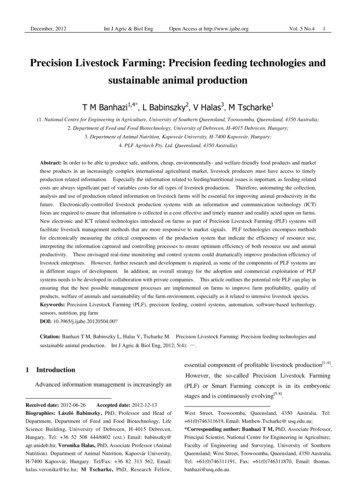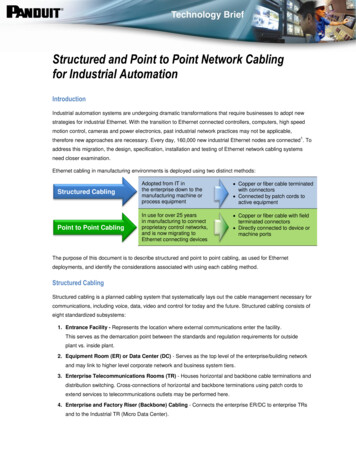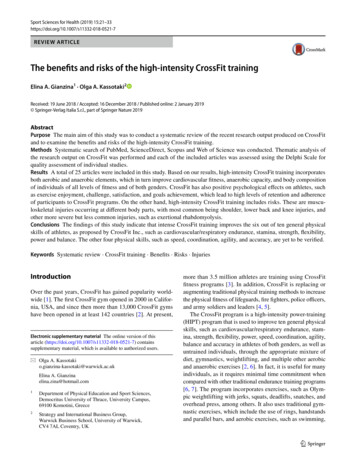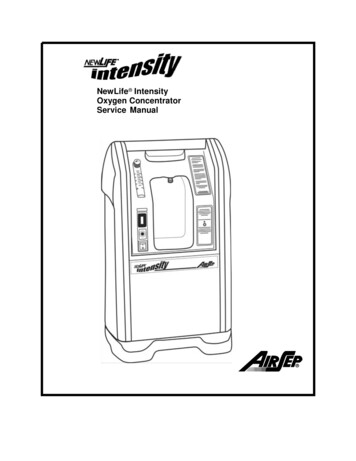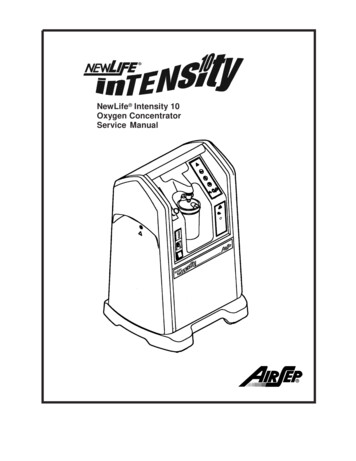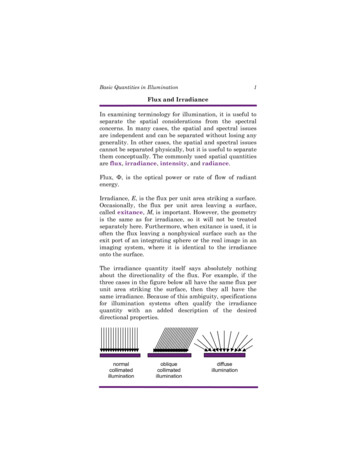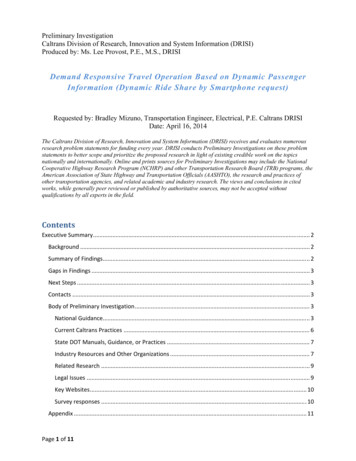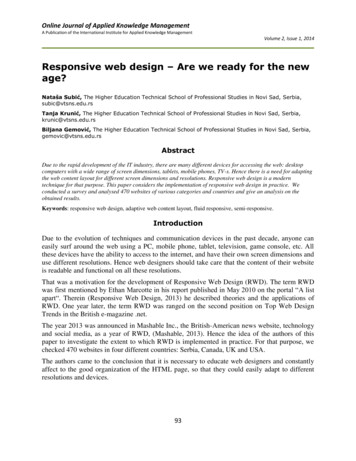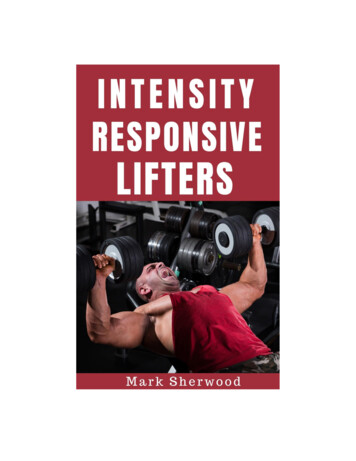
Transcription
Intensity Responsive LiftersMark SherwoodFor more information from the author visit:http://www.precisionpointtraining.com/
Copyright 2019 by Mark SherwoodIntensity Responsive LiftersBy Mark SherwoodThe author and publisher of the information in this book are not responsible in any manner for physicalharm or damages that may occur in response to following the instructions presented in this material. Aswith any exercise program, a doctor’s approval should be obtained before engaging in exercise.
Table Of ContentsIntroductionChapter 1: Always Train To FailureChapter 2: Forced RepsChapter 3: Rest Pause Reps And Rest Pause ClustersChapter 4: Partial Rep BurnsChapter 5: NegativesChapter 6: Pre-ExhaustChapter 7: Drop Sets or Strip SetsChapter 8: ExercisesChapter 9: How Much Training And How Often?Chapter 10: Change Your WorkoutsChapter 11: Rep SpeedChapter 12: Warm up SetsChapter 13: Sample High Intensity WorkoutsChapter 14: Workout SchedulesChapter 15: The High Intensity OptionAbout The AuthorAdditional Resources
IntroductionIn the 1970’s, a talented young bodybuilder by the name of Mike Mentzer was doing his best to ascendthe ranks of competitive bodybuilding. His journey started out with a very basic training program as anearly adolescent. By the time he was 15, he had already developed an outstanding body. Having a tasteof bodybuilding success, he began to add on to his basic three sets per muscle group workouts. Hereasoned that he needed to do this because all of the top bodybuilders that he knew about were doinghigh volume workouts.Arnold Schwarzenegger, Franco Columbu, Ronnie Robinson, Sergio Oliva, and Bill Pearl were just a fewexamples of the top bodybuilders who commonly did 20 sets or more per muscle group. This being thecase, Mentzer believed he needed to turn up his training volume to develop his body to the same extentas the top pros. Oddly enough, as he added on more volume, his gains began to slow down.Mike knew that just about every bodybuilder finds it harder to keep gaining muscle after a few years oftraining. This being the case, when he saw that his gains in muscle size had slowed down, he attributedthe slower gains to the fact that he had already been working out for several years. He figured the solutionwas simply to train more. If he increased his training to 10 sets and it stopped working, he would need toup his training to 15 sets, and then 20 sets, and as many sets as needed to keep gaining. It took him awhile to figure out that high volume training was incompatible with his particular physiology.While Mike Mentzer was doing longer and longer workouts, a young phenom rocked the bodybuildingworld by winning the Mr. America as an 19 year old. The bodybuilder was Casey Viator who confoundedmany in the bodybuilding world by developing incredible size and strength with three brief workouts perweek. When Mike heard about this, he thought back to his early days of training when he was only doinga few sets per muscle group and making very nice gains in size and strength. He wondered if he was doingmore harm than good with his long high-volume workouts and decided to return to the brief workoutsthat he had done in his early years of training. Suddenly, he started to gain again to the point where heentered the Mr. America Contest and won. He then entered the Mr. Universe and won and came veryclose to winning the Mr. Olympia with a second-place finish to Frank Zane.Mentzer realized that volume was not the main training mechanism that triggered muscle size andstrength; at least not in his own experience. Mike concluded that intensity of effort was the key to sizeand strength, and any time he needed to improve, he found ways to increase his training intensity. Hebecame famous for developing a high intensity method that he referred to as Heavy Duty Training.Mike had a brother named Ray. Both utilized the same high intensity style of training, and both developedamazing physiques with simple, brief workouts. About a decade later a bodybuilder by the name of DorianYates began his reign as a six-time Mr. Olympia. Dorian was also a proponent of high intensity training.Mike Mentzer, Ray Mentzer, and Dorian Yates, all have one thing in common, they are highly responsiveto high intensity training. None of them needed to do long workouts consisting of tons of sets and reps.They responded better to short workouts and only a few sets per muscle group. Among powerlifters, KirkKarwoski only needed one heavy work set per week for squats, deadlifts, and bench presses to developan enormous amount of strength and a monstrous set of muscles that many bodybuilders would beenvious of. These men are examples of intensity responsive lifters.
I personally do not believe that high intensity training is the best option for everyone, but it would befoolish to deny the tremendous results that some lifters have experienced in response to high intensitytraining. How do you determine whether or not you are responsive to high intensity training? You musttry it to see how your body responds to it.The purpose of this book is to provide examples of high intensity training that you can try in order todetermine whether or not you are responsive to high intensity training. If you love hard training, you willbe eager to start using the high intensity methods that are outlined in this book.
Chapter 1Always Train To FailureHigh intensity training is based on exerting a high amount of effort to complete a set of an exercise. Themost basic training concept that forces you to use a high amount of effort is to push for max reps to failureon every set that you perform. This simply means to keep repeating reps as long as possible until youreach the point where you will fail to complete any more reps, no matter how hard you try to do more.Of course, the last rep of a set will be the hardest rep and you should barely be able to complete the lastrep.If you have the ability to repeat more reps within a set, but you stop before doing as many reps as possible,you are not doing high intensity training. Training to failure takes a high amount of effort, but it is theminimum requirement for high intensity training. You must always train to failure on all of your work setswhen doing an honest to goodness high intensity workout. If you want to train even harder, there are highintensity methods that will help you to train beyond failure. These methods will be explained as youcontinue to read through this book.
Chapter 2Forced RepsAre you motivated enough to train beyond failure? This is a requirement if you want to maximize theintensity of your workouts. One method that can be used for training beyond the point of failure is toperform forced reps. You will need the help of a training partner for most exercises if you want toincorporate forced reps into your workouts. Forced reps are done when you have pushed to the point offailure and can no longer do any more reps on your own. This is where a training partner steps in andpushes or pulls up on the bar with just enough force to help you barely complete another rep. Thecompletion of a rep with the help of a training partner is called a forced rep.After reaching the point of failure, I recommend that you do one to three forced reps. You must besensitive about how many forced reps are beneficial. What generally happens when you keep repeatingforced reps is that your training partner starts to do more and more of the lifting for you. If your trainingpartner is getting more of a workout than you are when assisting you with forced reps, it’s time to stopthe set. There isn’t much point in weight lifting if you reach the point where you are so weak that youcan’t lift any of the weight.Self-Assisted Dips and Self Assisted Pull upsForced reps can be performed for some exercises without the assistance of a training partner to help youlift the weight. For example, most sets of dipping bars have a cross bar or a platform where you can placeyour feet. This allows you to use your feet and legs to push yourself up into the top position where yourarms are straight before lowering yourself when doing dips. The advantage of this is that when you reachthe point of failure where you can no longer lift yourself with your arms, you can start using your legs justenough to help you push yourself back up into the top position of your dips. These would be consideredself-assisted dips in order to perform forced reps.You can do self-assisted forced reps with pullups the same way you do self-assisted dips. Of course, youmust have a foot platform or a cross bar under the pull up bar where you can place your feet in order touse your legs to assist with the pull ups.
Chapter 3Rest-Pause Reps And Rest-Pause ClustersIt is possible that you don’t have a training partner to help you with forced reps, but you still want to dohigh intensity workouts. One alternative is to utilize Rest-Pause Training. The concept behind rest-pausetraining is simple, you push to failure until you can’t do any more reps. Rack the bar or put your weightsdown and rest or pause just long enough to regain enough strength to do another rep. You must learnhow much time is needed to recover enough strength to barely be able to do one more rep. You can thenpause just long enough to regain enough strength to do another rep and repeat this process until youhave done two to four rest pause reps at the end of your set.When done correctly, each rest-pause rep should require an all-out effort to complete the rep. These repsare a perfect substitute for forced reps. Not only that, but you must actually lift the weight yourself insteadof recruiting the help of a training partner.Rest-Pause Cluster SetsRest-pause cluster sets are a lot like rest-pause reps except that you rest-pause just a little longer so thatyou can perform two or three reps instead of just one rep. For example, if you perform eight reps andcan’t do a ninth rep because you reached the point of failure, you put the weight down and rest-pausejust long enough to do two or three more reps. You then rest long enough to do another two or three repsand repeat the process until you have done two to four clusters of two or three reps. Every cluster setshould take a maximum effort in order to squeeze out two to three reps.Rest-Pause Cluster Sets With Forced RepsIf you have a training partner when doing rest-pause cluster sets, you can push to failure and rest-pausejust long enough to do one or two reps on your own, and require a little assistance to do one more repwith the help of a training partner. You can do this for every cluster set if you are looking for a way to upthe intensity.
Chapter 4Partial Rep BurnsLarry Scott was the very first Mr. Olympia who won the contest in 1965 and 1966. He was famous for hismassive arms and deltoids. One of the training techniques that he used to build his arms was what areoften referred to as partial reps, or burns, or partial rep burns. Partial rep burns are done by training tofailure and when you can no longer do another full rep, you just do a partial rep. An example will help toexplain this.Imagine that you perform 10 reps of curls for your biceps, but you cannot do an eleventh rep, so you justmove the bar as far as you can instead of doing a complete rep. If you can only do a half rep, just do a halfrep. If you can’t do a half rep any more and can only move the bar three inches, just lift the bar threeinches. However far you can move the bar, move it as far as you possibly can with an all-out effort. It mayresult in being able to move the bar several inches, or just one inch. Do at least four partial rep burns afterreaching the point of failure.I believe partial rep burns work best with isolation exercises such as curls for your biceps, tricepsextensions, and dumbbell lateral raises for your deltoids. They also work good for leg extensions, leg curls,and calf raises. If you want to do partial reps for presses or pushing motions for your legs, I recommendusing machines. In other words, use a bench press or overhead press machine, and use a leg press machinefor your legs.
Chapter 5NegativesThose who rely upon high intensity training techniques will sometimes do negative reps. This simplymeans to train to failure and when you can’t lift the weight up any more, you should still have enoughstrength left to slowly lower the weight. Of course, the awkward part about negatives is that it oftenrequires two training partners who end up lifting the weight for you so that you can lower it. Negativesreally don’t work very well for squats or any exercise where you are using extremely heavy weights.A couple of exercises that work very well in conjunction with negatives are self-assisted dips and pull ups.This works a lot like doing self-assisted forced reps with dips and pull ups which was explained in chaptertwo. The difference is that you use your legs to lift yourself into the top position, and then you use yourarms to slowly lower yourself without any assistance from your legs.
Chapter 6Pre-ExhaustOne of the problems with compound exercises such as the bench press is that it utilizes both big musclesand small muscles. To be more specific, the triceps muscles of the arms are small compared to the muchlarger pectoral muscles of the chest. Since the triceps muscles are smaller, they tend to tire out beforethe chest muscles are used to the full extent of their lifting capacity when bench pressing. This meanswhen you stop a set, it’s not because your chest muscles have failed, it’s because your triceps muscleshave failed from exhaustion. It also means that you had to stop the set before your chest muscles reachedthe point of exhaustion and your chest muscles were never really forced to produce a high intensity effort.The solution to this problem is called the pre-exhaust method.If we continue to consider the chest and triceps muscles, the pre-exhaust method is done
Mike Mentzer, Ray Mentzer, and Dorian Yates, all have one thing in common, they are highly responsive to high intensity training. None of them needed to do long workouts consisting of tons of sets and reps. They responded better to short workouts and only a few sets per muscle group. Among powerlifters, Kirk Karwoski only needed one heavy work set per week for squats, deadlifts, and bench .
